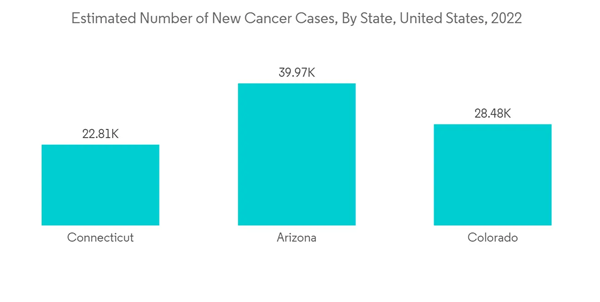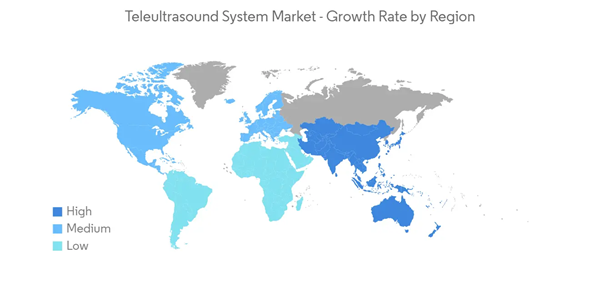Key Highlights
- The emergence of COVID-19 significantly impacted the market growth. During the initial phase of the pandemic, video consultations became more popular to reduce the number of hospital visits and avoid the risk of infection. Teleultrasound (TUS) gained traction during that time due to its advanced application for disease diagnosis.
- As per an article published in June 2022 in the Journal of Ultrasound in Medicine and Biology, ultrasound played a crucial role in emergency triage and provided clear benefits in identifying COVID-19 pneumonia for specific patient populations, including expectant mothers, children, and immobile patients. Hence, the TUS gained demand, and the application of TUS increased over time.
- As per the source above, TUS was incorporated as an obvious step to improve the capabilities of telehealth (TH) during the COVID-19 period, as TUS is an advanced technology with diagnostic precision and image quality comparable to regular ultrasound exams. Hence, the pandemic had a considerably positive impact on the studied market and is expected to continue its strong hold over the forecast period.
- Factors such as the introduction of technologically advanced diagnostics, increasing prevalence of target diseases, and growing geriatric population base are expected to contribute to the market growth over the forecast period.
- The growth of the studied market is attributed to the increasing prevalence of target diseases such as cancer and cardiovascular diseases. For instance, according to the 'UK Factsheet' published by the British Heart Foundation (BHF) in August 2022, there are around 7.6 million people in the country who suffer from heart and circulatory disorders, with almost 4 million men and 3.6 million women. Patients with heart and circulatory diseases, which are extremely common, drive demand for new diagnostic options. As telehealth has grown in popularity in recent years, it is projected that the incidence of diseases will open up new opportunities for the market under study and accelerate market expansion.
- Moreover, the increasing availability of technologically advanced products and other strategic activities by the major players is also boosting the market studied. For instance, in March 2022, GE Healthcare strategically invested USD 50 million in Pulsenmore Ltd and entered the homecare segment through Pulsenmore's handheld TUS device that docks with a smartphone, allowing women to perform ultrasound self-scans at home and receive fast clinical feedback from healthcare professionals. Such developments are anticipated to drive market growth during the forecast period.
- However, the lack of skilled professionals and data security and privacy concerns are likely to hamper the market growth over the forecast period.
Teleultrasound System Market Trends
Real-Time Teleultrasound Segment is Expected to Witness a Healthy Growth
- Real-time ultrasound systems are practical because they enable synchronous (real-time) remote ultrasonographic tests. Thus, it is anticipated that the real-time TUS system will expand positively.
- As per an article published in August 2021 in the Journal of Echocardiography, the emergence of a novel ultrasound device that enables real-time screen sharing and telecommunication with remote doctors has gained demand recently. That provides a unique opportunity for doctors unable to perform the traditional ultrasound to provide expert advice during a real-time consultation by using real-time TUS.
- In addition, as per the source above, when the study researchers used a novel tablet-based hand-held ultrasound device that enables TUS, it provided improved echocardiography results. Thus, owing to such instances, the real-time TUS is gaining demand and is anticipated to fuel segmental growth.
- Furthermore, prehospital emergency ultrasonography support for emergency medicine practitioners may be possible with the development of remote real-time supervision. For instance, Philips Ultrasound Systems EPIQ and Affiniti Collaboration Live allow clinicians to collaborate in real-time with colleagues to complete image acquisition and diagnosis regardless of location. These advanced technology and features are expected to drive segmental growth. Therefore, the above factors show an increase in the adoption of real-time TUS, and it is expected to fuel the segment growth over the forecast period.
North America Holds a Significant Share in the Market and Expected to do Same in the Forecast Period
- North America holds a major market share in the studied market and is anticipated to maintain its stronghold during the forecast period. The growth is majorly attributed to the increase in chronic diseases such as cancer and cardiology, the geriatric population, and the availability of technically advanced products.
- As a branch of telemedicine, TUS can potentially solve the problem of insufficient medical resources for high-quality ultrasound examinations, including breast ultrasound screening. It can also help physicians without ultrasound experience to perform cancer screenings. The major factor behind the market growth is the increasing burden of cancer in North American countries. For instance, according to the Cancer Facts and Figures 2022 published by the American Cancer Society (ACS), nearly 1.9 million new cancer cases will likely be diagnosed in the United States in 2022.
- In addition, according to the National Cancer Institute (NCI) 2022 update, breast cancer is the most common cancer. As per the source above, it is estimated that there will be 290,560 new breast cancer cases in the United States in 2022. Prostate cancer and lung cancer are the next most frequent cancers in the country. This burden of cancer is anticipated to increase the screenings related to cancer. This is further expected to increase demand for TUS systems, thereby driving the market growth over the forecast period.
- Furthermore, the adoption of TUS systems by various hospitals and clinics in the region is expected to contribute to market growth. For instance, in May 2022, Jefferson Radiology implemented advanced telemedicine software for its diagnostic ultrasound appointments. Collaboration Live, a TUS software by Philips™, will dramatically improve patient access by enabling radiologists to connect with patients virtually and in real-time. Thus, such instances are expected to contribute to regional market growth.
- Hence, the studied market is anticipated to witness growth owing to the TUS adoption in North America's cancer screening during the forecast period.
Teleultrasound System Market Competitor Analysis
The teleultrasound system market is competitive and consists of several major players. In terms of market share, a few major players dominate the market. Some companies currently dominating the market are Koninklijke Philips N.V, Remote Medical Technologies, LLC, Robo Medical, AdEchoTech, T-MedRobotics, and Pulsenmore Ltd., among others.Additional benefits of purchasing the report:
- The market estimate (ME) sheet in Excel format
- 3 months of analyst support
This product will be delivered within 2 business days.
Table of Contents
Companies Mentioned (Partial List)
A selection of companies mentioned in this report includes, but is not limited to:
- Koninklijke Philips N.V.
- Remote Medical Technologies, LLC
- Robo Medical
- AdEchoTech
- T-MedRobotics
- Analogic Corporation
- AMD Global Telemedicine
- ONRAD, Inc.
- Ram Soft, Inc.
- Medica Group PLC.
- Pulsenmore Ltd.
- BMV Medtech Group Co., Ltd.










